Adding Installed Transporters
After you have installed a Transporter, you need to add it to NAKIVO Backup & Replication so that the Transporter can be used for backup, replication, and recovery tasks. Refer to the following topics:
Installed Service
Please follow the steps below to add a Transporter that is installed as a service:
-
Click Settings in the left pane of the product dashboard and go to the Transporters tab.
-
Click Add Existing Transporter and then click Installed service in the dialog that opens.

-
The Add Existing Transporter - Installed Service dialog opens. In the Hostname or IP box, enter the IP address or a hostname of the machine on which the Transporter is installed.
Note
If you are adding the Transporter by a DNS name, make sure this DNS name can be resolved on the machines on which the Director and any other Transporters (which you plan to use in conjunction with the current one) are installed. -
Click More options and fill out the following fields:
-
In the Security section:
-
Master Password: Optionally, you can set a password to secure the connection. The set password must match the one configured on the Transporter. Note that setting a master password is required when the Enable Direct Connect for this Transporter option is enabled. Proceed as follows:
-
After entering the password, click Connect.
-
The Certificate Details dialog box appears. Verify the certificate details, and click Accept.
Notes
-
The master password must adhere to the following requirements:
-
Minimal length - 5 characters.
-
Maximum length - 50 characters.
-
-
The master password can be set and re-set manually by running the command on the machine housing the Transporter. Follow these steps:
-
Enter the following command
bhsvc -b P@ssword123 -
Restart the Transporter service.
-
-
-
-
-
In the Networking section:
-
Transporter port: Specify the port number that will be used to connect to the Transporter.
-
Data transfer ports: Specify a range of port numbers (from 1 to 65535) that will be used to transfer data. The range you specify should contain at least 100 ports. Make sure that the ports you specify are open in your firewall.
-
-
In the Settings section:
-
Transporter name: Specify a display name for the Transporter.
-
Maximum load: Specify the maximum number of tasks that the Transporter should process simultaneously. A task, for example, is a backup or replication of a single VM disk, or one granular recovery session.
-
Additional load for recovery jobs: If selected, the specified amount of tasks will be added to set maximum transporter load to be used for recovery jobs exclusively. This allows running the specified amount of concurrent recovery jobs along with other types of jobs without the need to wait for their completion.
-
Enable Direct Connect for this transporter: When this option is enabled, you can access remote resources via a single port connection without establishing a VPN connection. The following conditions must be met at the remote infrastructure to enable this feature:
-
The NAKIVO Transporter must be installed.
-
A master password must be set for security reasons. A pre-shared key is generated based on the entered master password.
-
The Transporter port on the local machine must be exposed to be externally available via the internet.
-
-
Enable debug logging for this transporter: If needed, enable debug level logging for the current transporter. It is not recommended to use this option on a permanent basis.
-
-
-
Click Add.

The Transporter is added to the product and is ready to be used for backup, replication, and recovery.
VMware Appliance
Please follow the steps below to add a Transporter that is deployed as a VMware appliance:
-
Click Settings in the left pane of the product dashboard and go to the Transporters tab.
-
Click Add Existing Transporter and then click VMware appliance in the dialog that opens.
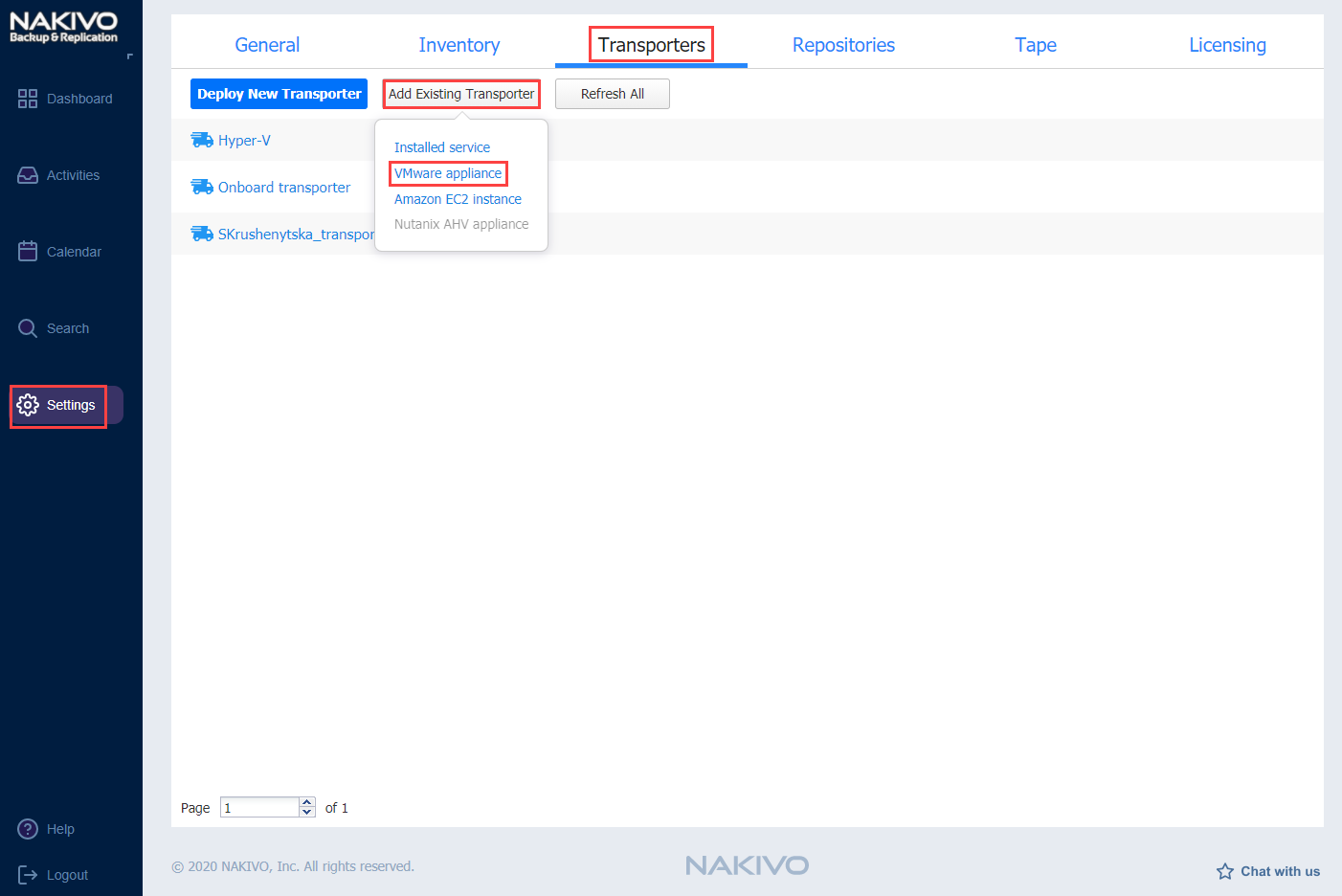
-
The
VMware Appliancedialog opens. Fill out the fields as described below:-
In the Host or cluster box, enter the IP address or name of the host or the cluster where the corresponding virtual machine is deployed.
-
In the Virtual machine box, specify the virtual machine on which the Transporter is installed.
-
In the OS Username and OS Password fields, specify credentials for accessing the virtual machine.
-
Click More options and fill out the following fields:
-
In the Networking section:
-
Transporter port: Specify the port number that will be used to connect to the Transporter.
-
Data transfer ports: Specify a range of port numbers (from 1 to 65535) that will be used to transfer data. The range you specify should contain at least 100 ports. Make sure that the ports you specify are open in your firewall.
-
-
In the Settings section:
-
Transporter name: Specify a display name for the Transporter.
-
Maximum load: Specify the maximum number of tasks that the Transporter should process simultaneously. A task, for example, is a backup or replication of a single VM disk, or one granular recovery session.
-
Additional load for recovery jobs: Selecting this option reserves the Transporter's resources exclusively for recovery jobs. This allows you to run recovery jobs concurrently with other types of jobs without the need to wait for their completion. The Transporter resources will be reserved according to the specified number.
-
Enable debug logging for this transporter: If needed, enable debug level logging for the current transporter. It is not recommended to use this option on a permanent basis.
-
-
-
-
Click Add.
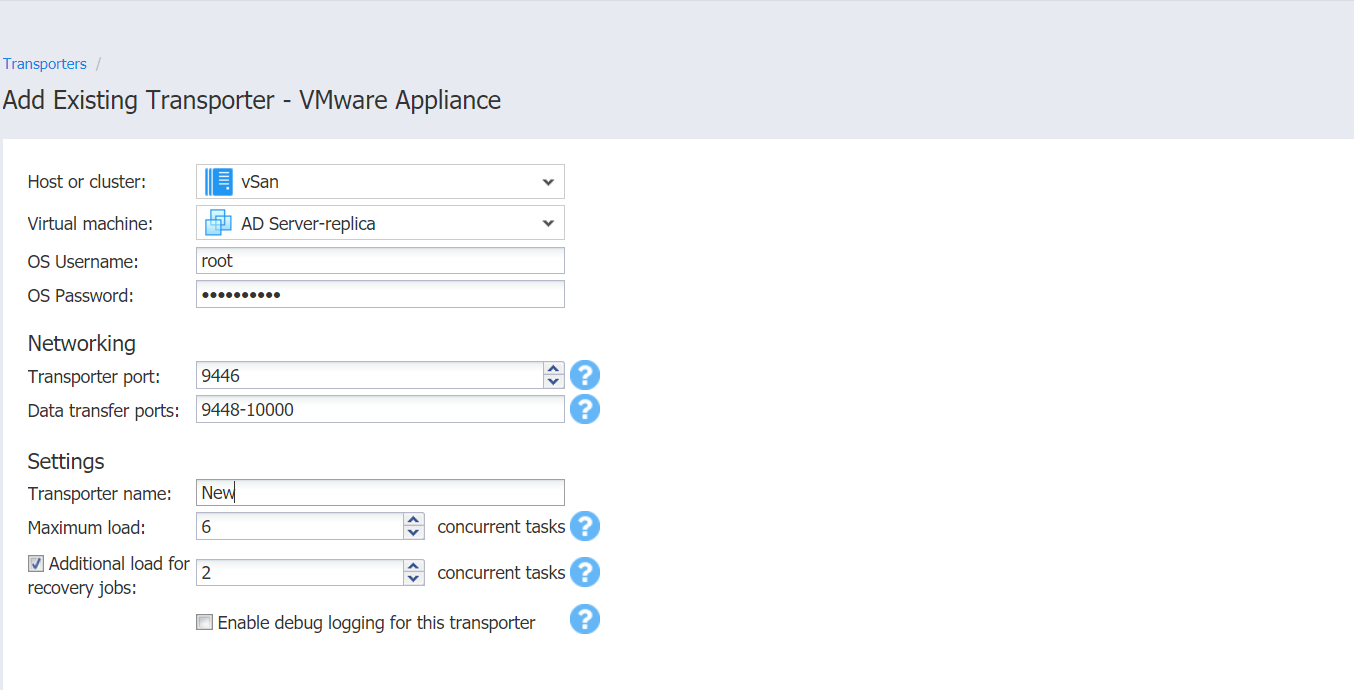
The Transporter is added to the product and is ready to be used for backup, replication, and recovery.
Amazon EC2 Instance
If you have already deployed a Transporter in Amazon EC2 and now wish to re-import the Transporter in a new instance of NAKIVO Backup & Replication, do the following:
-
Click Settings in the left pane of the product dashboard and go to the Transporters tab.
-
Click Add Existing Transporter and then click Amazon EC2 instance in the popup that opens.
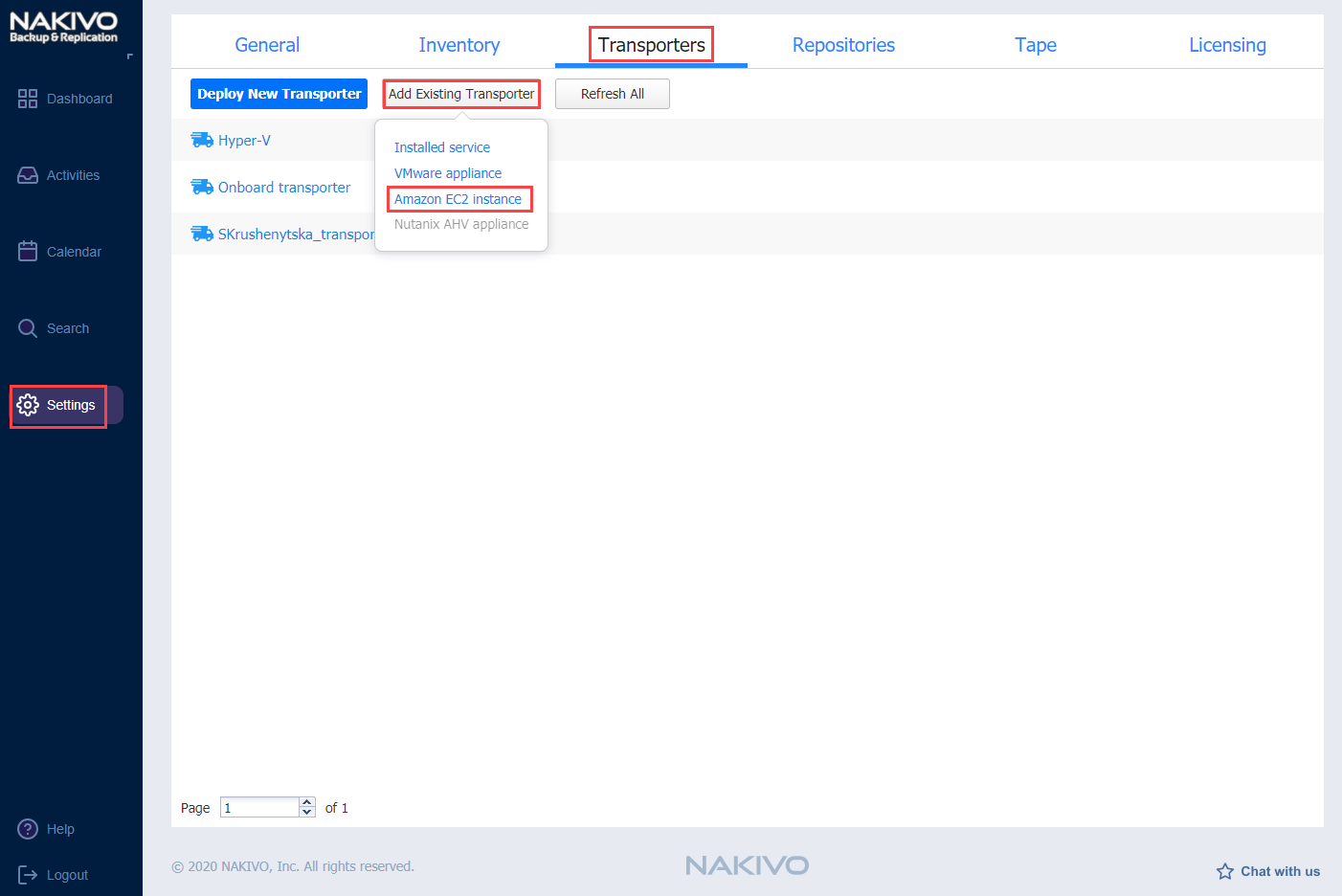
-
The Amazon EC2 Instance dialog opens. Fill out the fields as described below:
-
AWS account: Choose an appropriate Amazon AWS Account from the list of Amazon AWS Accounts added to the Inventory.
-
Region: Choose a region in which an AWS EC2 instance with the Transporter is deployed.
-
EC2 Instance: Select the Amazon EC2 Instance with the Transporter that you wish to add to the product.
-
Private key: Click the Browse button to locate and upload the Private key for the Transporter Instance that was created when you deployed the Transporter in the cloud.
-
Click More options and fill out the following fields:
-
In the Networking section:
-
Transporter port: Specify the port number that will be used to connect to the Transporter.
-
Data transfer ports: Specify a range of port numbers (from 1 to 65535) that will be used to transfer data. The range you specify should contain at least 100 ports. Make sure that the ports you specify are open in your firewall.
-
-
In the Settings section:
-
Operation mode: Choose either of the following Transporter operation modes:
-
Always running
-
Running while required
-
-
Transporter name: Specify a display name for the Transporter.
-
Maximum load: Specify the maximum number of tasks that the Transporter should process simultaneously. A task, for example, is a backup or replication of a single VM disk, or one granular recovery session.
-
Additional load for recovery jobs: If selected, the specified amount of tasks will be added to set maximum transporter load to be used for recovery jobs exclusively.
-
Enable debug logging for this Transporter: If needed, enable debug level logging for the current transporter. It is not recommended that you use this option on a permanent basis.
-
-
-
-
Click Add.
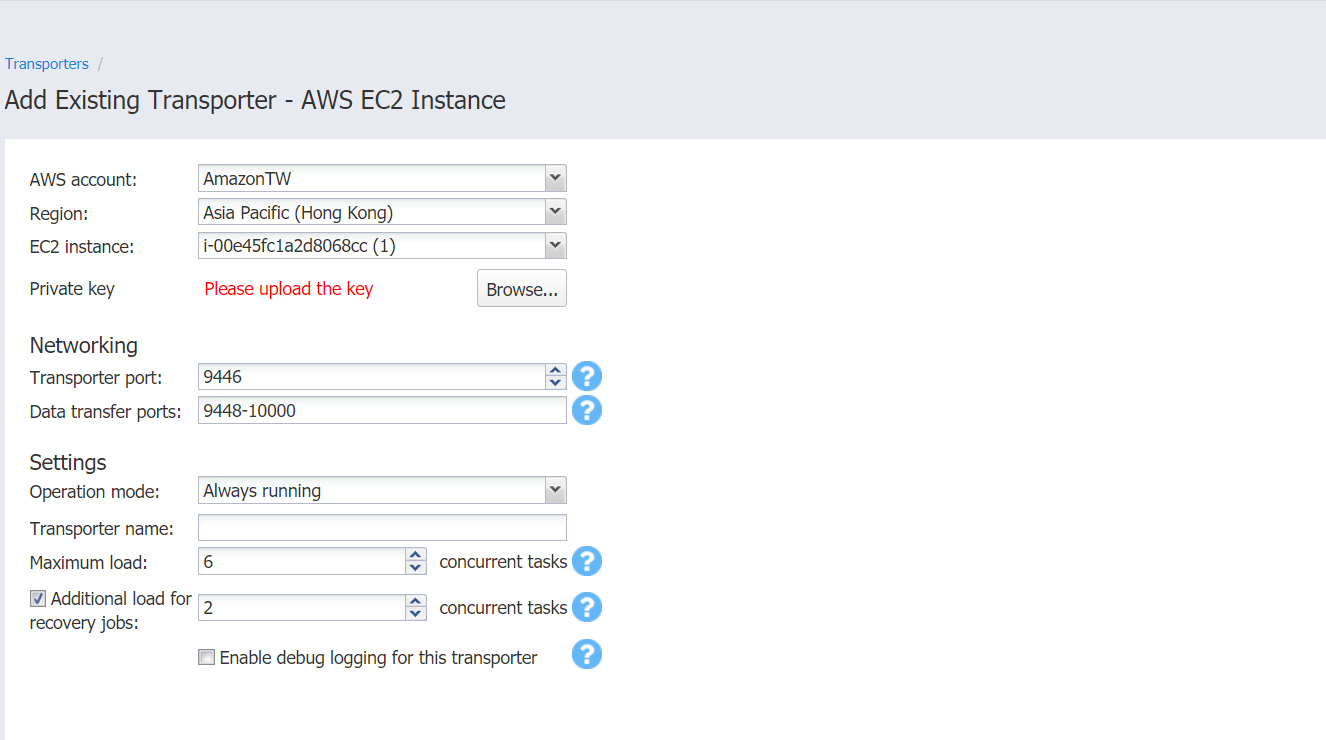
The Transporter is added to the product and is ready to be used for backup, replication, and recovery tasks.
Nutanix AHV Appliance
Please follow the steps below to add a Transporter that is deployed as a Nutanix AHV appliance:
-
Click Settings in the left pane of the product dashboard and go to the Transporters tab.
-
Click Add Existing Transporter and then select Nutanix AHV Appliance.
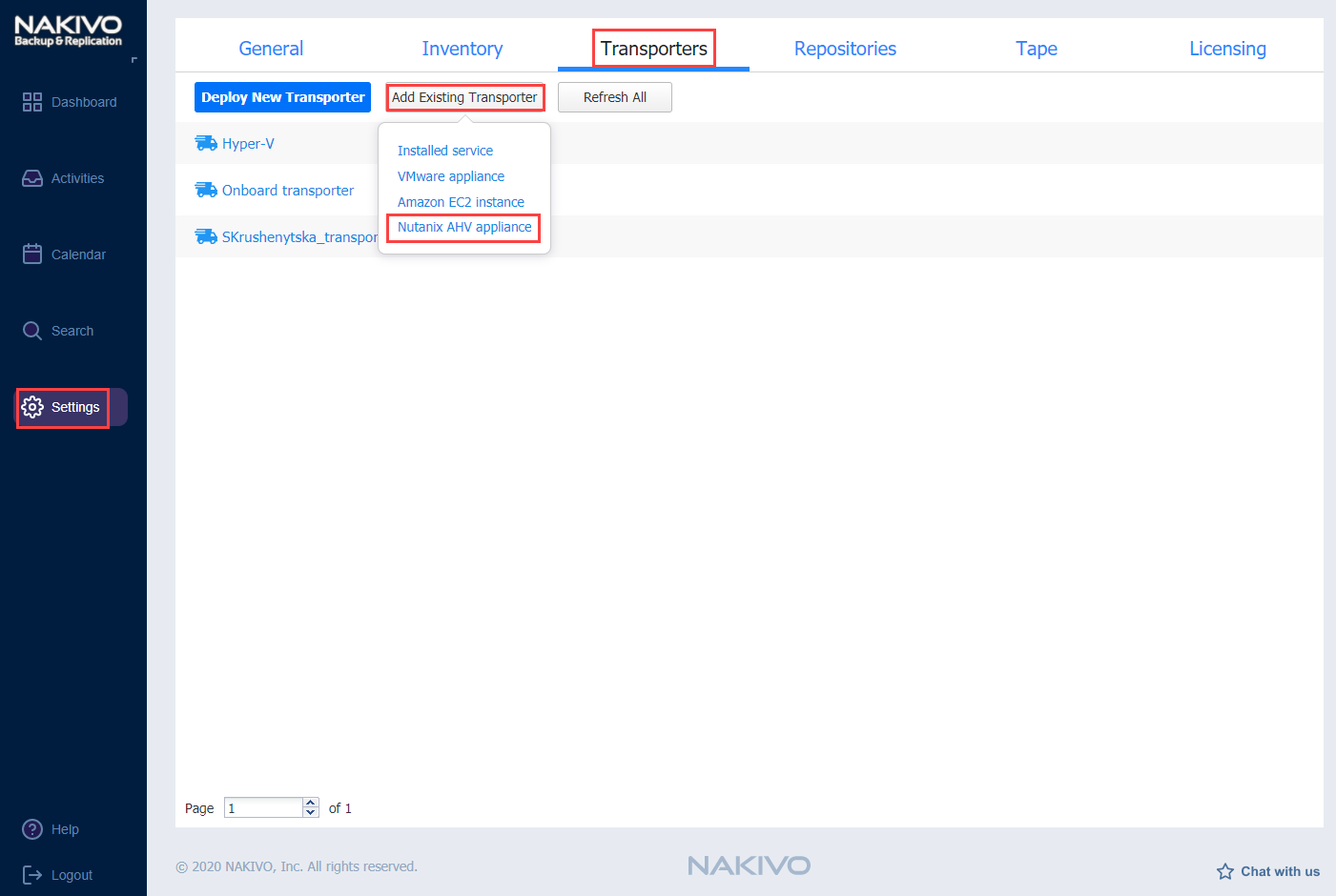
-
In the Add Existing Transporter - Nutanix AHV Appliance dialog, enter the following options:
-
Cluster: Select a cluster where the corresponding virtual machine is deployed.
-
Virtual machine: Select the virtual machine on which the Transporter is installed.
-
Username/Password: Enter credentials for accessing the virtual machine where the Transporter is installed.
-
Transporter port: Enter the port number that will be used to connect to the Transporter.
-
Data transfer ports: Enter a range of port numbers (from 1 to 65535) that will be used to transfer data. The range you specify should contain at least 100 ports. Make sure that the ports you specify are open in your firewall.
-
Transporter name: Enter a display name for the Transporter.
-
Maximum load: Select the maximum number of tasks that the Transporter should process simultaneously. A task, for example, is a backup or replication of a single VM disk, or one granular recovery session.
-
Additional load for recovery jobs: If selected, the specified amount of tasks will be added to set maximum transporter load to be used for recovery jobs exclusively.
-
Enable debug logging for this transporter: If needed, enable debug level logging for the current transporter. It is not recommended that you use this option on a permanent basis.
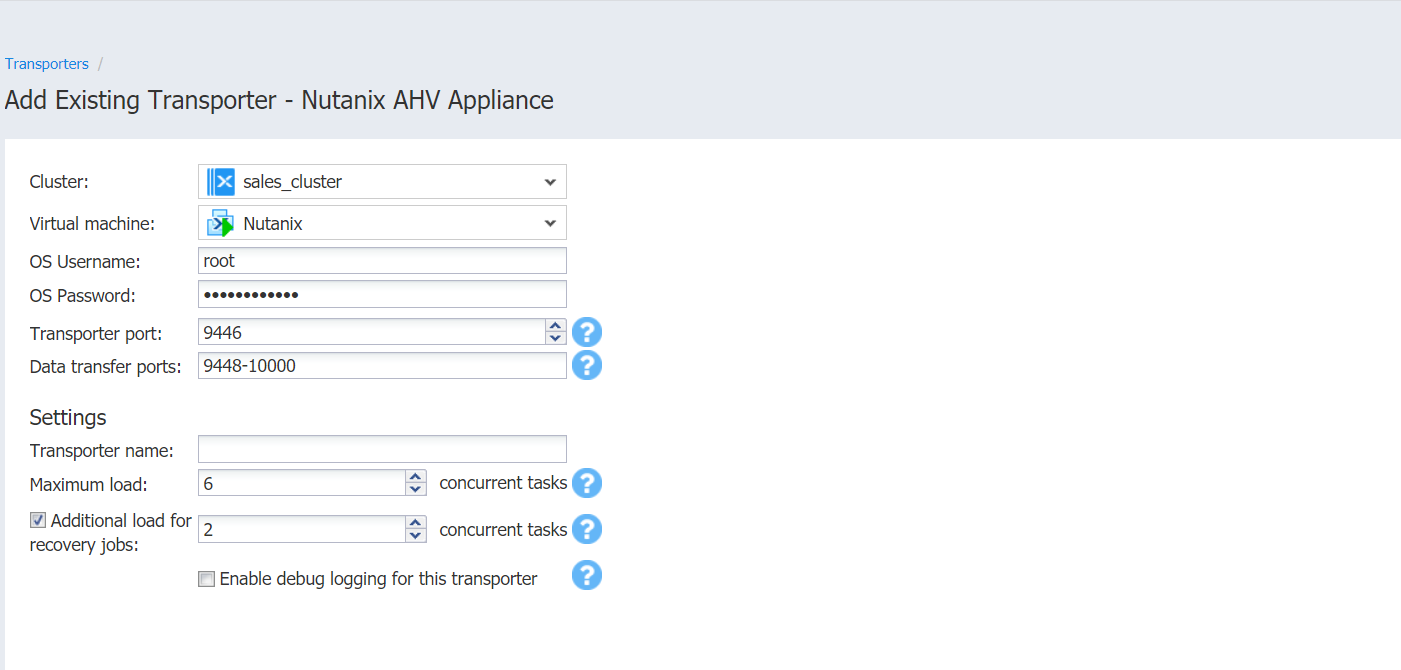
-
-
Click Add. The Transporter is added to the product and can be used for backup, replication, and recovery.